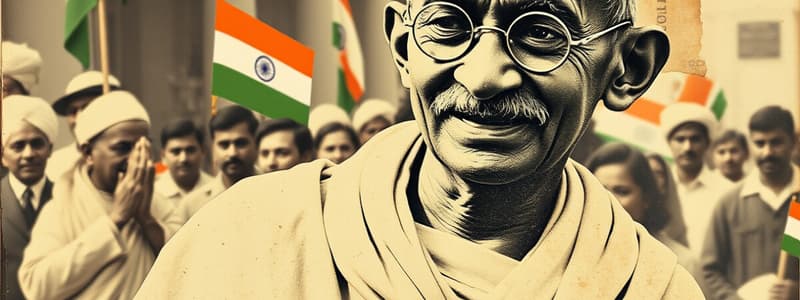Podcast
Questions and Answers
What was the primary focus of the early nationalism phase in India's independence movement?
What was the primary focus of the early nationalism phase in India's independence movement?
- Demanding greater representation and reforms. (correct)
- Participating in global anti-colonial protests.
- Advocating for armed resistance against British rule.
- Fostering economic ties with British investors.
Which event during the moderate phase intensified the anti-colonial sentiment in India?
Which event during the moderate phase intensified the anti-colonial sentiment in India?
- Jallianwala Bagh massacre.
- Partition of Bengal. (correct)
- Quit India Movement.
- The Salt March.
Which leader is most closely associated with the concept of non-violent resistance in the Indian independence movement?
Which leader is most closely associated with the concept of non-violent resistance in the Indian independence movement?
- Mahatma Gandhi. (correct)
- Jawaharlal Nehru.
- Bal Gangadhar Tilak.
- Subhas Chandra Bose.
What significant event took place during the Civil Disobedience Movement?
What significant event took place during the Civil Disobedience Movement?
Which factor is NOT typically associated with the reasons leading to India's independence?
Which factor is NOT typically associated with the reasons leading to India's independence?
Who was the leader of the Indian National Army during World War II?
Who was the leader of the Indian National Army during World War II?
What major event occurred in India on August 15, 1947?
What major event occurred in India on August 15, 1947?
Which movement called for an immediate end to British rule in India during World War II?
Which movement called for an immediate end to British rule in India during World War II?
Flashcards are hidden until you start studying
Study Notes
Overview of the Independence Movement in India
-
Historical Context
- India's struggle for independence began in the late 19th century.
- Primarily driven by British colonial rule since the 18th century.
-
Key Phases of the Movement
-
Early Nationalism (1885-1905)
- Formation of the Indian National Congress (INC) in 1885.
- Demand for greater representation and reforms.
-
Moderate Phase (1905-1919)
- Leaders like Dadabhai Naoroji and Gopal Krishna Gokhale advocated gradual reform.
- The partition of Bengal in 1905 sparked widespread protests.
-
Radical Phase (1919-1947)
- Emergence of leaders like Bal Gangadhar Tilak and Bipin Chandra Pal.
- Jallianwala Bagh massacre in 1919 intensified anti-colonial sentiment.
- Non-Cooperation Movement (1920-1922) led by Gandhi.
-
-
Key Leaders
-
Mahatma Gandhi
- Advocated non-violent resistance (Satyagraha).
- Key movements: Salt March (1930) and Quit India Movement (1942).
-
Jawaharlal Nehru
- Prominent figure in INC; became India's first Prime Minister.
- Focused on social reforms and modernization.
-
Subhas Chandra Bose
- Advocated for armed struggle against British rule.
- Led the Indian National Army (INA) during WWII.
-
-
Important Movements
-
Non-Cooperation Movement (1920-1922)
- Boycott of British goods, schools, and institutions.
-
Civil Disobedience Movement (1930-1934)
- Salt March as a pivotal moment; widespread acts of defiance against British laws.
-
Quit India Movement (1942)
- Launched during WWII demanding an end to British rule.
- Widespread protests and significant arrests of leaders.
-
-
Factors Leading to Independence
- WWII weakened British economic and military power.
- Growing unrest and organized resistance from various segments of society.
- International pressure and changing global attitudes towards colonialism.
-
Partition of India (1947)
- India gained independence on August 15, 1947.
- Partition led to the creation of Pakistan, resulting in mass migration and communal violence.
-
Post-Independence
- India adopted a democratic constitution in 1950.
- Focus on nation-building and addressing socio-economic challenges.
Historical Context
- India's struggle for independence began in the late 19th century, influenced by British colonial rule established in the 18th century.
Key Phases of the Movement
- Early Nationalism (1885-1905)
- Formation of the Indian National Congress (INC) in 1885 aimed at increasing representation and political reforms.
- Moderate Phase (1905-1919)
- Leaders like Dadabhai Naoroji and Gopal Krishna Gokhale promoted gradual reforms.
- The partition of Bengal in 1905 ignited widespread protests across the country.
- Radical Phase (1919-1947)
- Rise of leaders such as Bal Gangadhar Tilak and Bipin Chandra Pal who advocated for more direct action.
- The Jallianwala Bagh massacre in 1919 significantly escalated anti-colonial sentiments.
- The Non-Cooperation Movement led by Gandhi from 1920 to 1922 marked a key resistance strategy.
Key Leaders
- Mahatma Gandhi
- Promoted non-violent resistance through the principle of Satyagraha.
- Led significant movements including the Salt March in 1930 and the Quit India Movement in 1942.
- Jawaharlal Nehru
- A prominent leader in the INC, later became India's first Prime Minister.
- Advocated for social reforms and modernization efforts.
- Subhas Chandra Bose
- Supported an armed resistance against British rule.
- Formed and led the Indian National Army (INA) during World War II.
Important Movements
- Non-Cooperation Movement (1920-1922)
- Involved the boycott of British goods, schools, and institutions as a form of protest.
- Civil Disobedience Movement (1930-1934)
- The Salt March became a pivotal event, leading to widespread acts of defiance against British laws.
- Quit India Movement (1942)
- Initiated during World War II, demanding an immediate end to British rule, leading to mass protests and arrests of key leaders.
Factors Leading to Independence
- The economic and military weakening of Britain post-World War II undermined colonial authority.
- Increasing unrest and organized resistance from diverse groups in Indian society.
- Heightened international pressure and shifting global perspectives against colonialism.
Partition of India (1947)
- India achieved independence on August 15, 1947, resulting in the formation of Pakistan.
- The partition caused massive migration and significant communal violence between religious groups.
Post-Independence
- India established a democratic constitution in 1950, laying the foundation for nation-building.
- Early focus on addressing socio-economic challenges faced by the newly independent country.
Studying That Suits You
Use AI to generate personalized quizzes and flashcards to suit your learning preferences.




